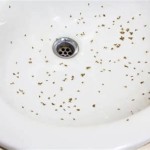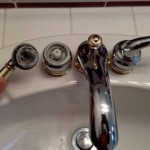Removing a 3-Hole Bathroom Faucet: A Comprehensive Guide
Removing a 3-hole bathroom faucet is a common task in plumbing maintenance and renovation. Whether replacing an old, leaky faucet, upgrading to a more modern style, or simply cleaning the existing fixture’s components, understanding the proper steps and precautions is crucial to a successful outcome. The process involves disconnecting water supply lines, disassembling the faucet hardware, and carefully removing the existing unit without damaging the sink or surrounding plumbing.
This article provides a detailed, step-by-step guide for removing a 3-hole bathroom faucet. It covers the necessary tools, safety considerations, and specific procedures to ensure the task is completed efficiently and effectively. Proper preparation and execution will minimize the risk of water damage, plumbing complications, and potential injuries during the removal process.
Preparing for the Removal Process
Before commencing the removal of a 3-hole bathroom faucet, adequate preparation is essential. This involves gathering the necessary tools, shutting off the water supply, and protecting the surrounding area from potential damage. Neglecting these preliminary steps can lead to unnecessary complications and potential hazards.
The following tools are typically required for this task:
- Adjustable wrench: For loosening and tightening nuts and bolts.
- Basin wrench (faucet wrench): Specifically designed for reaching and loosening faucet nuts in tight spaces.
- Pliers: For gripping and manipulating small parts.
- Screwdrivers (Phillips and flathead): To remove screws holding the faucet components in place.
- Penetrating oil: To loosen corroded or stuck nuts and bolts.
- Bucket or container: To catch any residual water in the pipes.
- Towels or rags: To absorb spills and protect surfaces.
- Safety glasses: To protect eyes from debris.
- Work gloves: To protect hands and provide a better grip.
- Flashlight or work light: To illuminate the work area.
After gathering the tools, the next crucial step is to shut off the water supply to the faucet. This is usually accomplished by turning off the shut-off valves located beneath the sink. These valves are typically small, oval-shaped handles that can be turned clockwise to stop the water flow. If shut-off valves are not present or are malfunctioning, the main water supply to the house must be shut off. This is generally located in the basement, garage, or near the water meter. Once the water supply is turned off, open the faucet to relieve any residual pressure in the pipes. Have a bucket or container ready to catch any remaining water.
Protecting the surrounding area is another important aspect of preparation. Place towels or rags around the sink and on the floor to absorb any spills and prevent scratches or damage to the countertop. Clear the area of any personal items or obstructions that may hinder the removal process. This thorough preparation will help minimize potential problems and ensure a smoother, more efficient removal.
Disconnecting Water Supply Lines and Faucet Components
The next stage involves disconnecting the water supply lines and disassembling the faucet components. This requires careful attention to detail and precision to avoid damaging the pipes or faucet parts. Rushing through this step can lead to leaks, broken connections, and other complications.
First, disconnect the water supply lines from the faucet tailpieces. These lines are typically connected with compression fittings or flexible hoses. Using an adjustable wrench, carefully loosen the nuts connecting the supply lines to the faucet. Be prepared for a small amount of water to drain out, even after shutting off the water supply. Have a bucket and towels ready to catch any spillage. If the nuts are corroded or difficult to loosen, apply penetrating oil and allow it to soak for a few minutes before attempting to loosen them again.
Once the water supply lines are disconnected, the next step is to disassemble the faucet components. This usually involves removing the nuts, screws, and other fasteners that hold the faucet in place. The specific configuration will vary depending on the faucet model. Typically, there are nuts or mounting brackets located beneath the sink that secure the faucet to the countertop. The basin wrench is often necessary to reach these nuts in the confined space under the sink. If the nuts are difficult to loosen, use penetrating oil and allow it to soak before attempting to remove them.
As you disassemble the faucet components, carefully keep track of all the parts and their order. This will be helpful if you are planning to reinstall the faucet later. Consider taking pictures or making notes as you disassemble the faucet to ensure proper reassembly, if needed. Once all the fasteners are removed, the faucet should be free to lift out of the sink.
Removing the Existing Faucet
With the water supply lines disconnected and the faucet components disassembled, the final step is to remove the existing faucet from the sink. This requires a gentle and careful approach to avoid damaging the sink or surrounding plumbing. Applying excessive force or using improper techniques can lead to cracks, leaks, or other problems.
Before attempting to lift the faucet, ensure that all connections and fasteners have been completely removed. Double-check for any remaining nuts, screws, or other hardware that may be holding the faucet in place. Once you are certain that everything is disconnected, gently lift the faucet up and out of the sink. If the faucet is stuck or difficult to remove, avoid forcing it. Instead, try gently rocking it back and forth to loosen any remaining sealant or debris that may be holding it in place.
After removing the faucet, thoroughly clean the sink area. Remove any old sealant, caulk, or debris that may be present. A plastic scraper or putty knife can be helpful for removing stubborn residue. Clean the sink surface with a mild detergent and water, and then dry it thoroughly. This will ensure a clean and smooth surface for installing the new faucet or re-installing the old one.
Inspect the sink and surrounding plumbing for any signs of damage or wear. Check the drain assembly for leaks or corrosion. If necessary, repair or replace any damaged components before installing the new faucet. Addressing any underlying issues at this stage will prevent future problems and ensure a long-lasting and reliable plumbing system.
Finally, dispose of the old faucet properly. If it is still in good condition, consider donating it to a local charity or recycling center. Otherwise, discard it according to local regulations for waste disposal. This completes the process of removing a 3-hole bathroom faucet, preparing the area for a replacement or re-installation. A meticulous and methodical approach to each step of this process ensures a positive outcome and minimizes the risks associated with plumbing work.

How To Remove A Bathroom Faucet

How To Replace 3 Hole Bathroom Sink Faucet

Replacing A Bathroom Faucet Fine Homebuilding

How To Remove And Install A Bathroom Faucet

How To Remove And Install A Bathroom Faucet

How To Replace 3 Hole Bathroom Sink Faucet

How To Remove And Install A Bathroom Faucet

How Do You Change A 3 Hole Faucet To 1 At Home With Ashley

How To Remove A Bathroom Faucet

How To Remove A Bathroom Faucet
Related Posts







